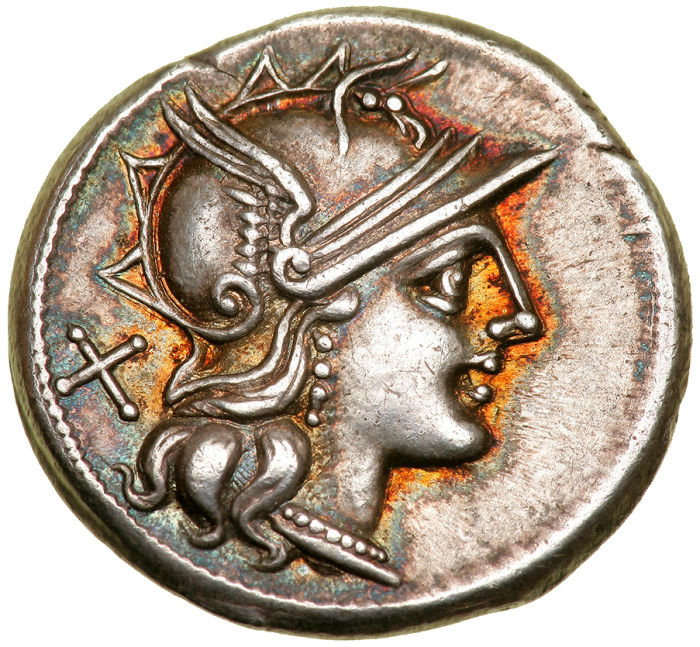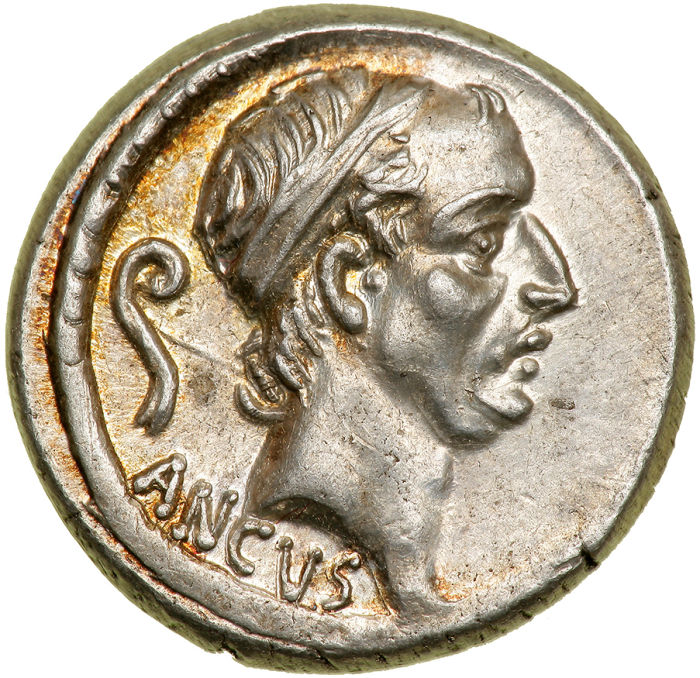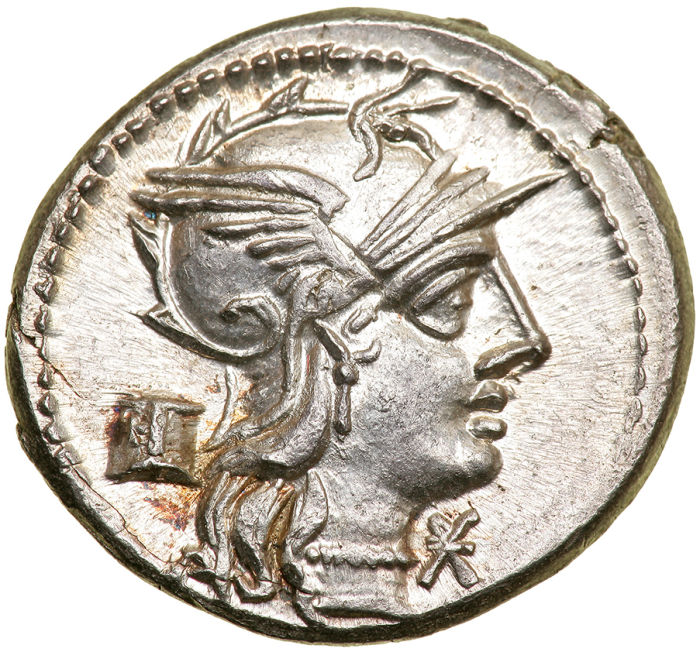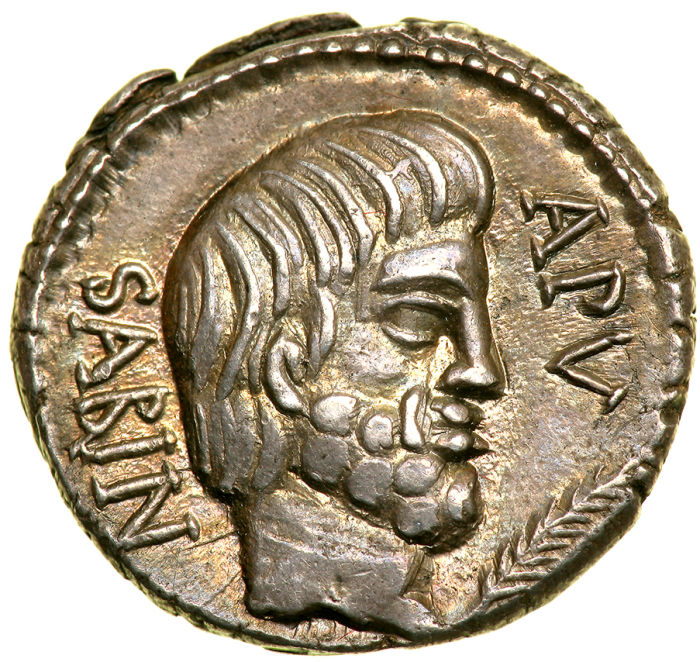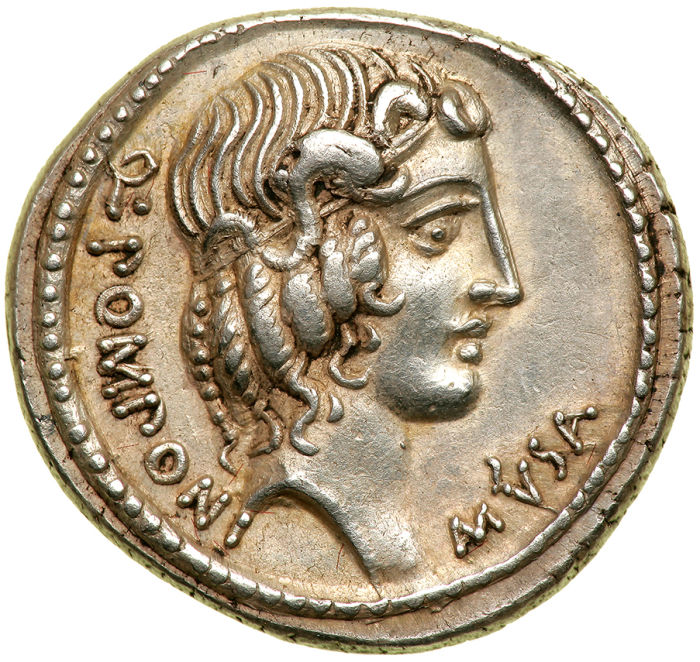denarii collection - roman republic - Coin Auctions
Lot 3061 - denarii collection - roman republic - Ira & Larry Goldberg Coins & Collectibles, Inc. Pre-Long Beach Auction #80Q. Sicinius. Silver Denarius (4.0 g), 49 BC. Rome. FORT P R, diademed head of Fortuna Populi Romani right. Reverse III VIR across field, Q SICINIVS, crossed palm branch and caduceus; above, wreath. Crawford 440/1; HCRI 410; Sydenham 938; Sicinia 5. A lustrous, beautiful specimen and delicately toned. Superb Extremely Fine. Ira & Larry Goldberg Coins & Collectibles, Inc. Pre-Long Beach Auction #80denarii collection - roman republic |
|
Lot 3003 - denarii collection - roman republic - Ira & Larry Goldberg Coins & Collectibles, Inc. Pre-Long Beach Auction #80C. Scribonius. Silver Denarius (3.89 g), 154 BC. Rome. Head of Roma right, wearing winged helmet ornamented with griffin's head; behind, X (denomination). Reverse C SCR below, ROMA in relief in linear frame in exergue, the Dioscuri on horseback riding right, each holding couched spear. Crawford 201/1; Sydenham 380; Scribonia 1. Well centered and attractively toned with traces of reddish iridescense. Extremely Fine. Ira & Larry Goldberg Coins & Collectibles, Inc. Pre-Long Beach Auction #80denarii collection - roman republic |
|
Lot 3014 - denarii collection - roman republic - Ira & Larry Goldberg Coins & Collectibles, Inc. Pre-Long Beach Auction #80C. Claudius Pulcher. Silver Denarius (3.94 g), 110-109 BC. Rome. Head of Roma right, wearing winged helmet ornamented with griffin's head and circular decoration on bowl. Reverse C PVLCHER in exergue, Victory, holding reins, driving galloping biga right. Crawford 300/1; Sydenham 569; Claudia 1. Finely detailed, delicately toned and perfectly centered. A superb example thus quite rare. Nearly Mint State. Ira & Larry Goldberg Coins & Collectibles, Inc. Pre-Long Beach Auction #80denarii collection - roman republic |
|
Lot 3035 - denarii collection - roman republic - Ira & Larry Goldberg Coins & Collectibles, Inc. Pre-Long Beach Auction #80Cn. Lentulus. Silver Denarius (4.01 g), 74 BC. Uncertain mint in Spain. G P R above, diademed and draped bust of the Genius of the Roman People right, scepter over shoulder. Reverse CN LEN Q in exergue, EX S C across field, scepter, globe, and rudder. Crawford 393/1a; Sydenham 752; Cornelia 54. Boldly struck and lustrous with delicate golden toning. Nearly Mint State. Ira & Larry Goldberg Coins & Collectibles, Inc. Pre-Long Beach Auction #80denarii collection - roman republic |
|
Lot 3054 - denarii collection - roman republic - Ira & Larry Goldberg Coins & Collectibles, Inc. Pre-Long Beach Auction #80L. Marcius Philippus. Silver Denarius (4.0 g), 57 BC. Rome. ANCVS below, diademed head of Ancus Marcius right; behind, lituus. Reverse PHILIPPVS on left, equestrian statue right on arcade of five arches; within arches, AQVA (MAR). Crawford 425/1; Sydenham 919; Marcia 18. Well struck and well centered, lustrous. Nearly Mint State. Ira & Larry Goldberg Coins & Collectibles, Inc. Pre-Long Beach Auction #80denarii collection - roman republic |
|
Lot 3009 - denarii collection - roman republic - Ira & Larry Goldberg Coins & Collectibles, Inc. Pre-Long Beach Auction #80M. Marcius Mn.f. Silver Denarius (3.93 g), 134 BC. Rome. Head of Roma right, wearing winged helmet ornamented with griffin's head; behind, modius; below chin, denomination. Reverse M (MAR)-C / RO-MA in two lines below, Victory, holding whip and reins, driving galloping biga right; below, two wheat ears dividing legend. Crawford 245/1; Sydenham 500; Marcia 8. Well struck, perfectly centered and lustrous. A touch of delicate golden toning adds to its appeal. Mint State. Ira & Larry Goldberg Coins & Collectibles, Inc. Pre-Long Beach Auction #80denarii collection - roman republic |
|
Lot 3028 - denarii collection - roman republic - Ira & Larry Goldberg Coins & Collectibles, Inc. Pre-Long Beach Auction #80L. Censorinus. Silver Denarius (4.06 g), 82 BC. Rome. Laureate head of Apollo right. Reverse L CENSOR, Satyr standing left, extending arm and holding wine skin over shoulder; behind, statue on column. Crawford 363/1d; Sydenham 737; Marcia 24. Lustrous and lightly toned. Nearly Mint State. Ira & Larry Goldberg Coins & Collectibles, Inc. Pre-Long Beach Auction #80denarii collection - roman republic |
|
Lot 3048 - denarii collection - roman republic - Ira & Larry Goldberg Coins & Collectibles, Inc. Pre-Long Beach Auction #80C. Calpurnius Piso L.f. Frugi. Silver Denarius (3.83 g), 61 BC. Rome. Laureate head of Apollo right; behind, Φ. Reverse C PISO L F FRVG, nude horseman wearing conical hat galloping right; above, sword. Crawford 408/1a (dies 33/1038); Hersh 89 (O33/R1038); Sydenham 846; Calpurnia 24j. Boldly struck in high relief and lustrous. A superb example. Nearly Mint State. Ira & Larry Goldberg Coins & Collectibles, Inc. Pre-Long Beach Auction #80denarii collection - roman republic |
|
Lot 3022 - denarii collection - roman republic - Ira & Larry Goldberg Coins & Collectibles, Inc. Pre-Long Beach Auction #80L. Titurius L.f. Sabinus. Silver Denarius (3.9 g), 89 BC. Rome. SABIN behind, bare head of King Tatius right; before, A PV; below chin, palm branch. Reverse [L] TITVRI in exergue, Tarpeia, facing, buried to her waist in shields, with raised hands she tries to thrust off two soldiers who are about to cast their shields onto her; above, star in crescent. Crawford 344/2c; Sydenham 699a; Tituria 5. Attractively toned. Superb Extremely Fine. Ira & Larry Goldberg Coins & Collectibles, Inc. Pre-Long Beach Auction #80denarii collection - roman republic |
|
Lot 3042 - denarii collection - roman republic - Ira & Larry Goldberg Coins & Collectibles, Inc. Pre-Long Beach Auction #80Q. Pomponius Musa. Silver Denarius (4.01 g), 65 BC. Rome. Q POMPONI MVSA, laureate head of Apollo right. Reverse HERCVLES MVSA RVM, Hercules Musagetes standing right, draped with lion's skin, playing lyre, club resting against leg. Crawford 410/1; Sydenham 810; Pomponia 8. An incredible example! Struck on a broad flan, well centered and of artistic style. Superb Extremely Fine. Ira & Larry Goldberg Coins & Collectibles, Inc. Pre-Long Beach Auction #80denarii collection - roman republic |


